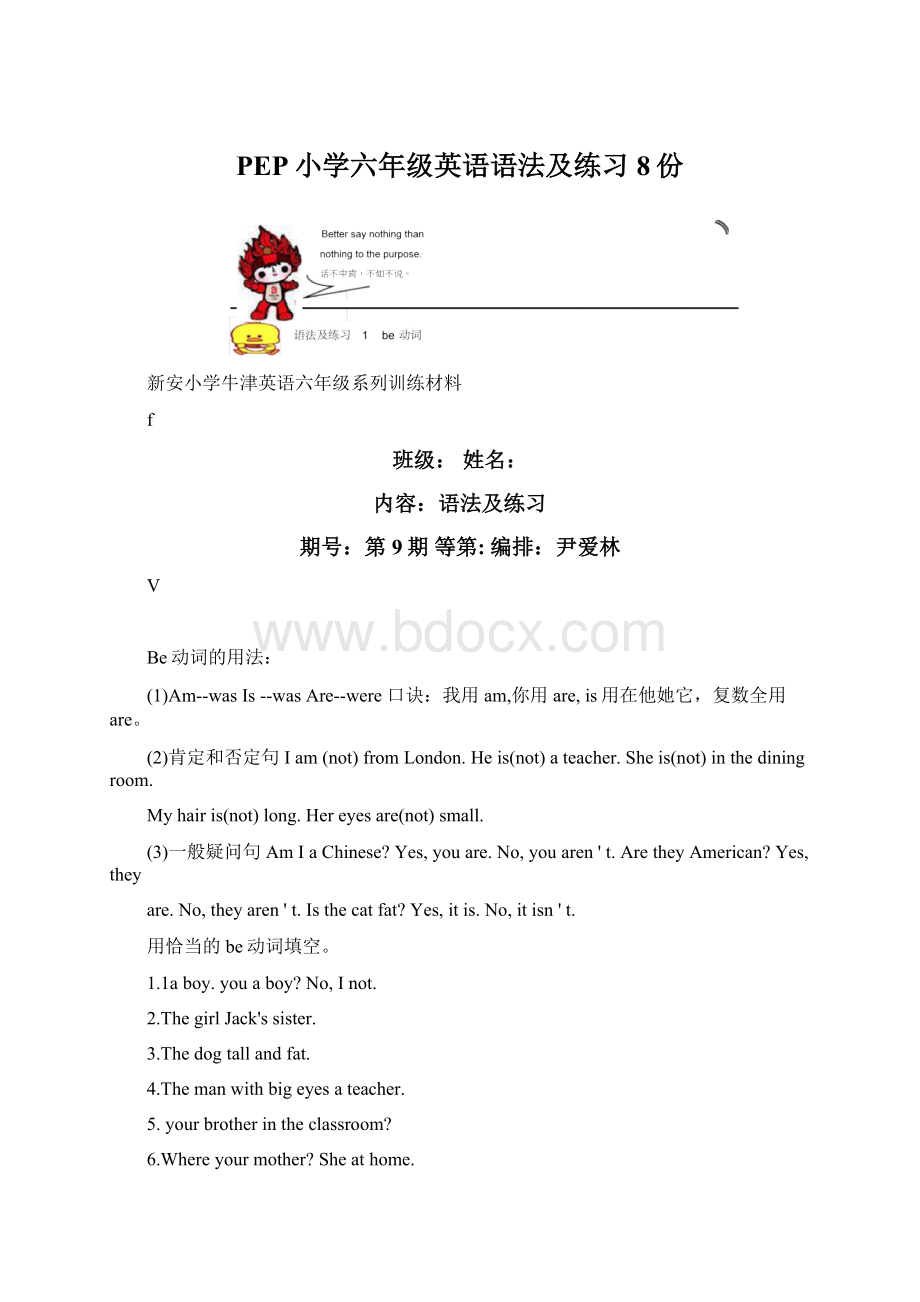PEP小学六年级英语语法及练习8份.docx
《PEP小学六年级英语语法及练习8份.docx》由会员分享,可在线阅读,更多相关《PEP小学六年级英语语法及练习8份.docx(16页珍藏版)》请在冰豆网上搜索。

PEP小学六年级英语语法及练习8份
新安小学牛津英语六年级系列训练材料
f
班级:
姓名:
内容:
语法及练习
期号:
第9期等第:
编排:
尹爱林
V
Be动词的用法:
(1)Am--wasIs--wasAre--were口诀:
我用am,你用are,is用在他她它,复数全用are。
(2)肯定和否定句Iam(not)fromLondon.Heis(not)ateacher.Sheis(not)inthediningroom.
Myhairis(not)long.Hereyesare(not)small.
(3)一般疑问句AmIaChinese?
Yes,youare.No,youaren't.AretheyAmerican?
Yes,they
are.No,theyaren't.Isthecatfat?
Yes,itis.No,itisn't.
用恰当的be动词填空。
1.1aboy.youaboy?
No,Inot.
2.ThegirlJack'ssister.
3.Thedogtallandfat.
4.Themanwithbigeyesateacher.
5.yourbrotherintheclassroom?
6.Whereyourmother?
Sheathome.
7.Howyourfather?
8.MikeandLiuTaoatschool.
9.Whosedressthis?
10.Whosesocksthey?
11.Thatmyredskirt.
12.WhoI?
13.Thejeansonthedesk.
14.Hereascarfforyou.
15.Heresomesweatersforyou.
16.TheblackglovesforSuYang.
17.ThispairofglovesforYangLing.
18.Thetwocupsofmilkforme.
19.Someteaintheglass.
20.Gaoshan'sshirtoverthere.
21.Mysister'snameNancy.
22.ThisnotWangFang'spencil.
23.DavidandHelenfromEngland?
24.Thereagirlintheroom.
25.Theresomeapplesonthetree.
26.thereanykitesintheclassroom?
27.thereanyapplejuiceinthebottle?
28.Theresomebreadontheplate.
29.Thereaboy,twogirls,threemenandtenwomeninthepark.
30.You,heandIfromChina.
◎语法及练习2人称代词和物主代词
than之
I
it
we
you
them
his
your
hers
人称代词和物主代词
1人称代词主格和宾格的区别:
主格通常位于句中第一个动词之前(有时候位于后),宾格一般位于动词或介词之后。
2•物主代词形容词性与名词性的区别:
形容词性用时后面一般要带上名词,名词性则单独使用,后面不带名词。
.填写代词表主格
用所给词的适当形式填空。
1.Thatisnotkite.Thatkiteisverysmall,butisverybig.(I)
2.Thedressis.Giveitto.(she)
3.Isthiswatch?
(you)No,it'snot.(I)
4.ismybrother.nameisJack.Look!
Thosestampsare
5.dressesarered.(we)Whatcolourare?
(you)
6.Herearemanydolls,whichoneis?
(she)
7.1canfindmytoy,butwhere's?
(you)
8.Showyourkite,OK?
(they)
9.Ihaveabeautifulcat.nameisMimi.Thesecakesare.(it)
10.Arethesetickets?
No,arenot.aren'he
11.Shallhavealookatthatclassroom?
Thatisclassroom.(we)
12.ismyaunt.Doyouknowjob?
anurse.(she)
13.Thatisnotcamera.isathome.(he)
14.Whereare?
Ican'tfind.Let'scall
15.Don'ttouch.notacat,atiger!
.(he)
.(they)
parents.(they)
16.sisterisill.Pleasegoandget.(she)
17.don'tknowhername.W(yoldpleasetell.(we)
18.Somanydogs.Let'scount.(they)
19.Ihavealovelybrother.isonly3.Ilikeverymuch.(he)
20.MayIsitbeside?
(you)
21.Lookatthatdesk.Thosebookareon.(it)
22.
Thegirlbehindisourfriend.(she)
一、名词复数规则
1.一般情况下,直接加-s,如:
book-books,bag-bags,cat-cats,bed-beds
2.以s.x.sh.ch结尾,力口-es,如:
bus-buses,box-boxes,brush-brushes,watch-watches
3.以辅音字母+y"结尾,变y为i,再力口-es,如:
family-families,strawberry-strawberries
4.以"或fe'结尾,变f或fe为v,再加-es,如:
knife-knives
5.不规则名词复数:
man-men,woman-women,policeman-policemen,policewoman-policewomen,mouse-micechild-childrenfoot-feet,.tooth-teethfish-fish,people-people,Chinese-Chinese,Japanese-Japanese
练习:
写出下列各词的复数。
一般现在时一般现在时基本用法介绍
一般现在时的功能
1.表示事物或人物的特征、状态。
如:
Theskyisblue.天空是蓝色的。
2.表示经常性或习惯性的动作。
如:
Igetupatsixeveryday.我每天六点起床。
3.表示客观现实。
如:
Theearthgoesaroundthesun地球绕着太阳转。
一般现在时的构成
1.be动词:
主语+be(am,is,are)+其它。
如:
Iamaboy.我是一个男孩。
2.行为动词:
主语+行为动词什其它)。
如:
WestudyEnglish.我们学习英语。
当主语为第三人称单数(he,she,it)时,要在动词后加"-s"或"-es"。
如:
MarylikesChinese.玛丽喜欢汉语。
一般现在时的变化
1.be动词的变化。
否定句:
主语+be+not+其它。
如:
Heisnotaworker.他不是工人。
一般疑问句:
Be+主语+其它。
如:
-Areyouastudent?
-Yes.Iam./No,I'mnot.特殊疑问句:
疑问词+一般疑问句。
如:
Whereismybike?
2.行为动词的变化。
否定句:
主语+don't(doesn't)+动词原形(+其它)。
如:
Idon'tlikebread.
当主语为第三人称单数时,要用doesn't构成否定句。
如:
Hedoesn'toftenplay.
一般疑问句:
Do(Does)+主语+动词原形+其它。
如:
-Doyouoftenplayfootball?
-Yes,Ido./No,Idon't.
当主语为第三人称单数时,要用does构成一般疑问句。
如:
-Doesshegotoworkbybike?
-Yes,shedoes./No,shedoesn't.特殊疑问句:
疑问词+一般疑问句。
如:
Howdoesyourfathergotowork?
一般现在时用法专练:
一、用括号内动词的适当形式填空。
1.Heoften(have)dinnerathome.
2.DanielandTommy(be)inClassOne.
3.We(notwatch)TVonMonday.
4.Nick(notgo)tothezooonSunday.
5.they(like)theWorldCup?
6.Whattheyoften(do)onSaturdays?
7.yourparents(read)newspaperseveryday?
8.Thegirl(teach)usEnglishonSundays.
9.SheandI(take)awalktogethereveryevening.
10.There(be)somewaterinthebottle.
11.Mike(like)cooking.
12.They(have)thesamehobby.
13.Myaunt(look)afterherbabycarefully.
14.Youalways(do)yourhomeworkwell.
15.I(be)ill.I'mstayinginbed.
16.She(go)toschoolfromMondaytoFriday.
17.LiuTao(do)notlikePE.
18.Thechildoften(watch)TVintheevening.
19.SuHaiandSuYang(have)eightlessonsthisterm.
20.-Whatday(be)ittoday?
-It'sSaturday.
二、按照要求改写句子。
1.DanielwatchesTVeveryevening.(改为否定句)
2.1domyhomeworkeveryday.(改为一般疑问句,作否定回答)
3.Shelikesmilk.(改为一般疑问句,作肯定回答)
4.Amylikesplayingcomputergames.(改为一般疑问句,作否定回答)
5.Wegotoschooleverymorning.(改为否定句)
6.HespeaksEnglishverywell.(改为否定句)
7.Iliketakingphotosinthepark.(对划线部分提问)
8.JohncomesfromCanada.(对划线部分提问)
9.Sheisalwaysagoodstudent.(改为一般疑问句,作否定回答)
10.SimonandDaniellikegoingskating.(改为否定句)
三、改错伐U出错误的地方,将正确的写在横线上)
1.IsyourbrotherspeakEnglish?
2.Doeshelikesgoingfishing?
3.Helikesplaygamesafterclass.
4.Mr.WuteachsusEnglish.
5.
Shedon'tdoherhomeworkonSundays.
5现在进行时
现在进行时
1•现在进行时表示现在正在进行或发生的动作,也可表示当前一段时间内的活动或现阶段正在进行的动作。
2.现在进行时的肯定句基本结构为be+动词ing.
3.现在进行时的否定句在be后加not。
4.现在进行时的一般疑问句把be动词调到句首。
5.现在进行时的特殊疑问的基本结构为:
疑问词不达意+be+主语+动词ing?
但疑问词当主语时其结构为:
疑问词不达意+be+动词ing?
动词加ing的变化规则
1.一般情况下,直接加ing,如:
cook-cooking
2.以不发音的e结尾,去e力口ing,如:
make-making,taste-tasting
run-running,stop-stopping
现在进行时专项练习:
1.Theboy(draw)apicturenow.
2.Listen.Somegirls(sing)intheclassroom.
3.Mymother(cook)somenicefoodnow.
4.Whatyou(do)now?
5.Look.They(have)anEnglishlesson.
6.They(not,water)theflowersnow.
7.Look!
thegirls(dance)intheclassroom.
8.Whatisourgranddaughterdoing?
She(listen)tomusic.
9.It's5o'clocknow.We(have)suppernow
10.Helen(wash)clothes?
Yes,sheis.
三、句型转换:
1.Theyaredoinghousework.(分别改成一般疑问句和否定句)
2.Thestudentsarecleaningtheclassroom.(改一般疑问句并作肯定和否定回答)
3.1'mplayingthefootballintheplayground.对划线部分进行提问)
4.
Tomisreadingbooksinhisstudy.(对划线部分进行提问)
6将来时
将来时
一、概念:
表示将要发生的动作或存在的状态及打算、计划或准备做某事。
句中一般有以下时间状语:
tomorrow,nextday(week,month,year…),soon,thedayafterto(m后天)等。
二、基本结构:
①begoingto+do;②will+do.
三、否定句:
在be动词(am,is,are)l后加not或情态动词will后加not成won'。
例如:
I'mgoingtohaveapicnicthisafternoon「I'mnotgoingtohaveapicnicthisafternoon.
四、一般疑问句:
be或will提到句首,some改为any,and改为or,第一二人称互换。
例如:
Wearegoingtogoonanoutingthisweekend.Areyougoingtogoonanoutingthis
weekend?
五、对划线部分提问:
一般情况,一般将来时的对划线部分有三种情况。
1.问人。
Who例如:
I'mgoingtoNewYorksoon.Who'sgoingtoNewYorksoon.
2.问干什么。
What…do例女口:
Myfatherisgoingtowatcharacewithmethisafternoon.Whatisyourfathergoingtodowithyouthisafternoon.
3.问什么时候。
When.例如:
She'sgoingtogotobedatnine^Whenisshegoingtobed?
六、同义句:
begoingto=will
Iamgoingtogoswimmingtomorrow(明天).=Iwillgoswimmingtomorrow.
练习:
填空。
1.我打算明天和朋友去野炊。
Ihaveapicnicwithmyfriends.
Ihaveapicnicwithmyfriends.
2.下个星期一你打算去干嘛?
我想去打篮球。
WhatnextMonday?
Iplaybasketball.WhatyoudonextMonday?
Iplaybasketball.
3.你妈妈这个周末去购物吗?
是,她要去买一些水果。
yourmothergoshoppingthis?
Yes,she.Shebuysomefruit.
4.你们打算什么时候见面。
Whattimeyoumeet?
改句子。
5.Nancyisgoingtogocamping.(改否定)
Nancygoingtogocamping.
6.I'llgoandjointhem改否定)
Igojointhem.
7.I'mgoingtogetupat6:
30tomorrow改一般疑问句)
togetupat6:
30tomorrow?
8.Wewillmeetatthebusstopat10:
30.(改一般疑问句)
meetatthebusstopat10:
30.
9.Sheisgoingtolistentomusicafterschool.(对划线部分提问)
sheafterschool?
10.Myfatherandmotheraregoingtoseeaplaythedayaftertomorrow.(同上)
goingtoseeaplaythedayaftertomorrow.
用所给词的适当形式填空。
11.Todayisasunnyday.We(have)apicnicthisafternoon.
12.Mybrother(go)toShanghainextweek.
13.Tomoften(go)toschoolonfoot.Buttodayisrain.He
(go)toschoolbybike.
14.Whatdoyouusuallydoatweekends?
Iusually(watch)TVand(catch)
insects?
15.It'sFridaytoday.Whatshe(dtoi)Bweekend?
She
(watch)TVand(catch)insects.
16.What(d0)youdolastSunday?
I(pick)applesonafarm.
What(do)nextSunday?
I(milk)cows.
17.Mary(visit)hergrandparentstomorrow.
18.LiuTao(fly)kitesintheplaygroundyesterday.
19.David(give)apuppetshownextMonday.
20.
I(plan)formystudynow.
语法及练习7一般过去时一般过去时
1•一般过去时表示过去某个时间发生的动作或存在的状态,常和表示过去的时间状语连
用。
一般过去时也表示过去经常或反复发生的动作感谢。
2.Be动词在一般过去时中的变化:
⑴am禾口is在一般过去时中变为was°(wasnot=wasn')t
⑵are在一般过去时中变为were。
(werenot=weren')t
⑶带有was或were的句子,其否定、疑问的变化和is,am,are一样,即否定句在was或were后加not,—般疑问句把was或were调到句首。
3•句中没有be动词的一般过去时的句子
否定句:
didn't动词原形,如:
Jimdidn'tgohomeyesterday.
一般疑问句:
在句首加did,句子中的动词过去式变回原形。
女口:
DidJimgohomeyesterday?
特殊疑问句:
⑴疑问词+did+主语+动词原形?
如:
WhatdidJimdoyesterday?
⑵疑问词当主语时:
疑问词+动词过去式?
如:
Whowenttohomeyesterday?
动词过去式变化规则:
1.一般在动词末尾加-ed,如:
pull-pulled,cook-cooked
2.结尾是e力口d,如:
taste-tasted
3.末尾只有一个元音字母和一个辅音字母的重读闭音节,应双写末尾的辅音字母,再加-ed,女口:
stop-stopped
4.以辅音字母+y"结尾的,变y为i,再加-ed,如:
study-studied
5.不规则动词过去式:
am,is-was,are-were,do-did,see-saw,say-said,gi